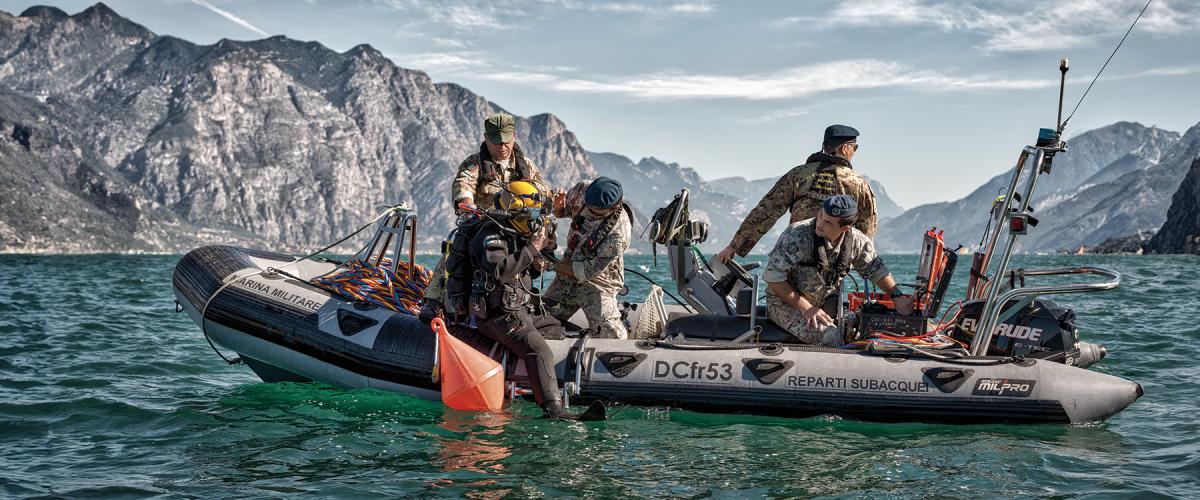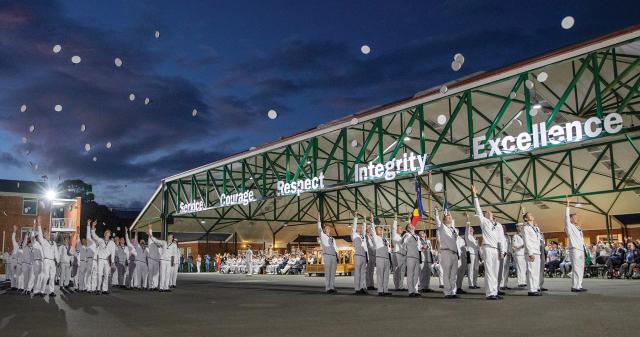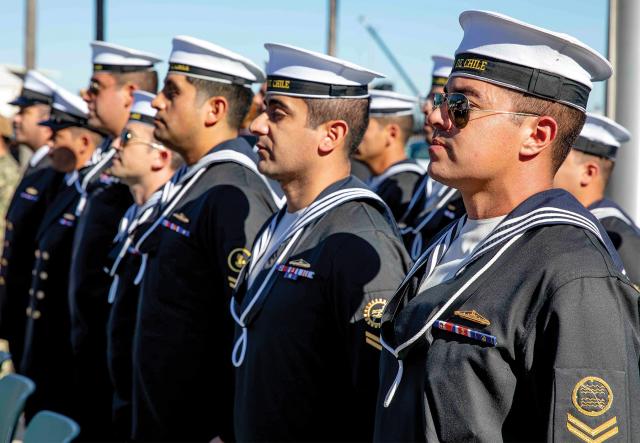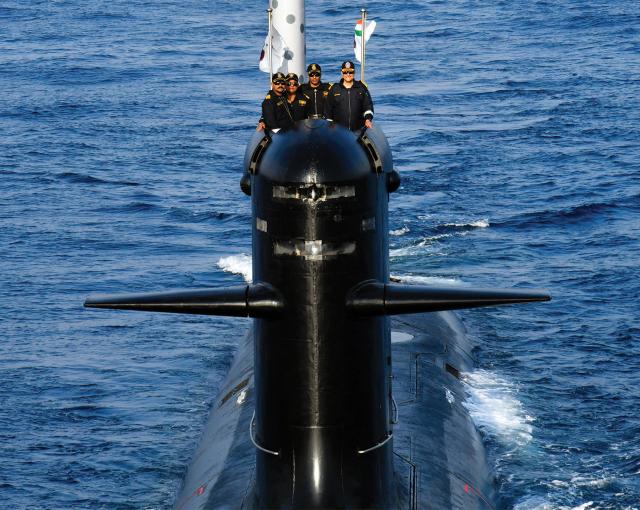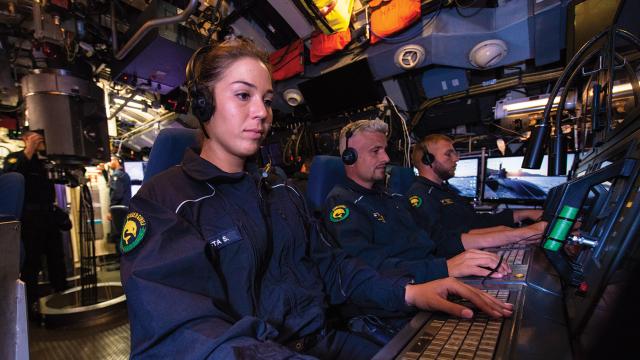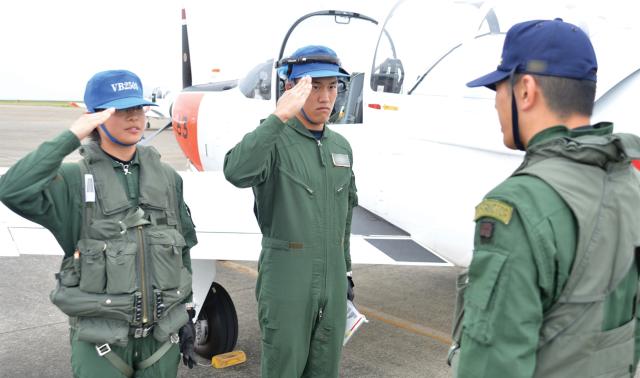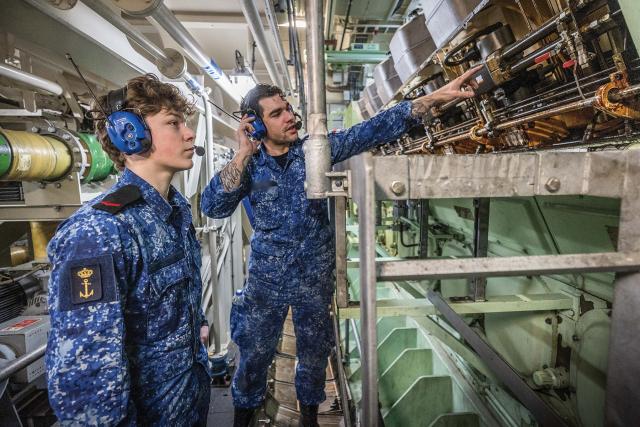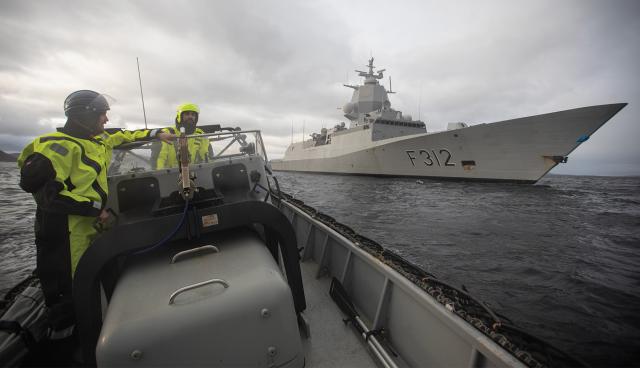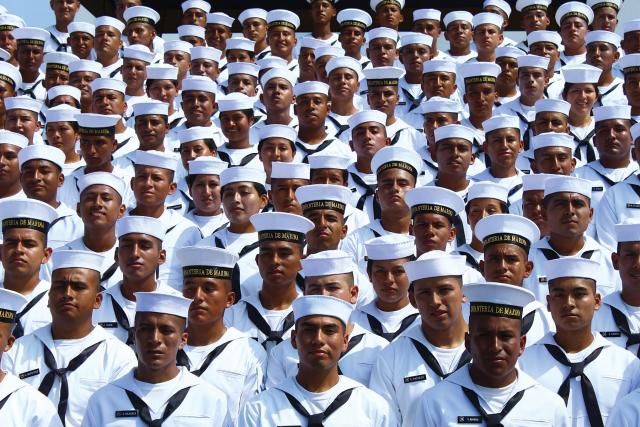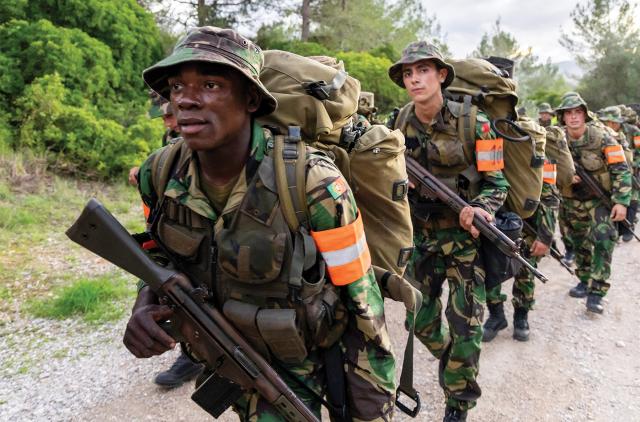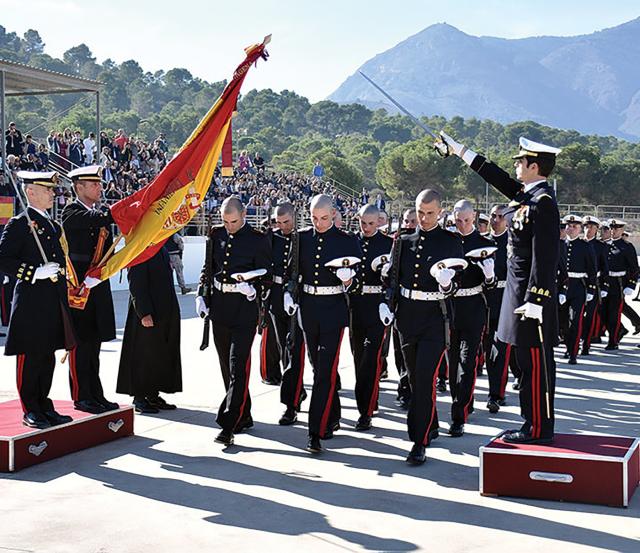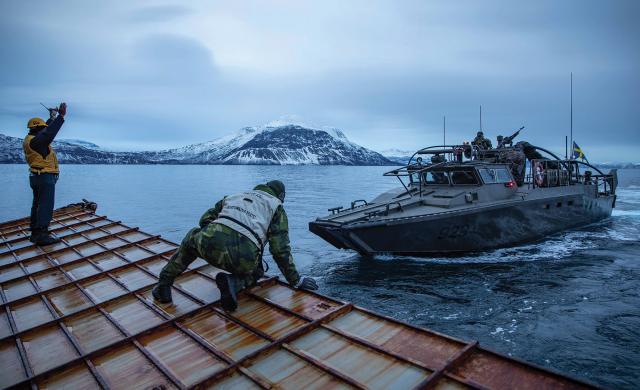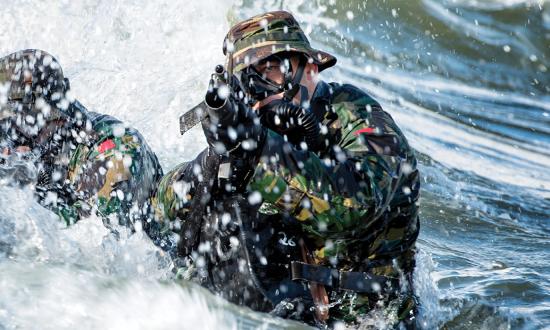Given the struggles the U.S. military is having recruiting and retaining young Americans, Proceedings asked the commanders of the world’s navies:
How are you addressing challenges in recruiting and retaining the newest generation, many of whom were born in this century, given their expectations for better work/life balance, compensation, and career flexibility? How are you adapting your training and personnel systems to account for these challenges?
AUSTRALIA
Vice Admiral Mark Hammond, AM, Chief of the Royal Australian Navy
Amid rising tensions in our region and farther afield, it can be easy to fixate on capability, to focus on the instruments of lethal force we must wield ethically and lawfully. However, our fleets are only great, hulking lumps of steel. It is our people who animate them and turn them into castles of steel that guard our shores and our prosperity. In other words, sailors are our buoyancy. They turn latent steel into a formidable and visible promise to defend. No ship sails without its sailors. They keep us afloat. Our sailors are our fleet.
Recognizing our human capital is appropriate and necessary but also frightening; a recent Randstad study on the Australian employment market found that 47.5 percent of business leaders regard talent acquisition as a pressing issue that keeps them awake at night. Talent is not a challenge unique to navies. So, how can navies be an employer of choice in such a market? The generation now entering the workforce has grown up largely in peace, as have many of their parents. Peacetime does not breed an understanding of the lethality–prosperity nexus, of how the threat of the former protects the latter. In a world of dwindling resources, disregard for international law, and coercion, the comforts of our daily life are not guaranteed.
So, what can we do? Simply, we have two options: evolve or fail. We must evolve our processes and optimize the way we recruit and retain people. Part of the initial challenge for us in Australia is reminding the public we are a maritime nation. My challenge is to get the Navy in front of the nation, and in front of young people, as much as possible. In a world of shortening attention spans, the story of our nation’s maritime history—and of what our Navy offers—must be distilled into short sound bites.
For the Australian Navy, we have implemented and will continue to analyze other ways to remove barriers to joining the service. This has included reviewing health and fitness requirements and developing specialist recruiting teams to access talent in diverse demographics of Australian society. We also have established a specialist retention team that launched our Stay Onboard program, which has implemented a variety of initiatives to make us an employer of choice.
However, one of the greatest changes must happen in our mindset. Among us old salts, we must ask ourselves the same question we ask of the Navy: Evolve or fail? Optimizing our processes and removing barriers to service are not only good things, but also a national necessity. This is an evolution, not a revolution. We are but custodians of our Navy, charged to care for it until the next generation takes the weight. We must evolve to ensure there is something to hand over.
BARBADOS
Commodore Errington R. Shurland, Chief of Staff, Barbados Defence Force
The decline in recruitment and retention is not unique to the U.S. military, but rather is an issue that confronts forces globally, including the Barbados Defence Force (BDF) over the past two decades. BDF recruitment numbers have been on a swift decline since 2011, and retention has continued to decline since 2018. In 2023, the BDF sought to recruit 120 but fell short by 40 and only retained 48 of the 80 by graduation.
The root causes of the decline in recruitment and retention are vast and cannot be discussed in their entirety here. Nonetheless, with the shift in factors of production from land and labor to information and knowledge and the rise of the “gig economy” made possible by the internet and smart technology, traditional careers in medicine, law, and the military have become less attractive to Generation Z. The internet has created an avenue for young people to earn ten times the monthly salary of the average traditional career job by creating content and using their knowledge from higher education in cyberspace.
Social media has been an avenue for cancel culture, distrust of institutions, and demonization of military response and action. Generation Z, which accounts for more than 80 percent of the military’s target audience, is indirectly indoctrinated by trending internet content that results in a greater lack of interest in and distrust for the military.
The restricted movement of people and human interaction during the COVID-19 pandemic had mental and physical fitness implications as well.
The BDF joins militaries globally in having difficulty enlisting recruits who can meet basic physical fitness requirements. In addition, the force has witnessed an increased number of individuals unable to withstand the mental rigors of basic training.
Militaries have generally accepted that society has drastically changed and the strategies for recruiting and retention in the 20th century are incapable of attracting the young people of the 21st century. Yet, the BDF continues to put old wine in new bottles. The military prides itself on being a conservative institution that holds dearly to tradition. Nonetheless, other conservative institutions have understood the need to change to remain relevant and attractive to the people they serve.
As the BDF marks its 45th anniversary, we seek to celebrate our proven excellence over the years. However, we also wish to reflect on our recent challenges, including recruitment and retention. Therefore, after consulting with officers, enlisted, and potential BDF recruits, I have proposed a nine-point Road Map of Recruiting and Retention that maximizes the benefits that can be gained from recruiting and retaining the 21st-century knowledge worker.
The nine points include: a thorough BDF skills analysis; revised career mapping; new career incentives; better morale, welfare, and recreation benefits; a better resocialization process for new recruits; a revised recruiting process that includes six to eight weeks of physical fitness preparation and relaxed drug, hair, and tattoo policies; deep research on impediments to retention; and a focus on servant leadership. I am confident that in following this road map we will improve BDF recruiting and retention.
CANADA
Vice Admiral Angus Topshee, Commander, Royal Canadian Navy
The Royal Canadian Navy (RCN) is facing some serious challenges right now. It is a difficult situation, but our issues are not unique. Historically, we have risen to every challenge, so I remain optimistic. Let there be no doubt that we remain ready to defend Canada in all three of our oceans and, alongside the United States, ensure the security of North America.
Many navies across the world are addressing similar issues in recruiting and retaining the newest generation, particularly in an era in which expectations for work/life balance, compensation, and career flexibility are paramount. While today’s generation, like each one before it, has its own unique views and challenges, we believe many still have a desire to serve their country and help ensure peace and security for all Canadians.
Our approach to overcoming these challenges is multifaceted, and it is a massive undertaking. People are the heart and soul of our naval force. History tells us the best sailors, not the best ships, win at sea. That is why the highest priority for the RCN remains attracting, recruiting, and training sailors to the occupational functional points to hold our trained effective strength at its current level.
One initiative we have implemented to attract new people is the Naval Experience Program (NEP) that launched in April 2023. This program offers young Canadians and permanent residents a one-year opportunity to gain firsthand experience of naval life, providing a glimpse into the rewarding careers available in the Navy and the opportunity to sail to the Arctic, a place Canadians care passionately about even though most never get the chance to experience it in person. The NEP is a powerful tool for attracting new recruits who may not have considered a military career previously.
The NEP also has forced the RCN to better manage all our personnel on the Basic Training List, delivering an improved experience for all trainees.
We have no choice but to change—and, as we undertake the largest peacetime recapitalization in our history, it is a perfect opportunity to reimagine our entire human resource model. We have launched a comprehensive analysis to reshape our occupations and define the optimal crewing model for our ships—to meet our operational commitments, generate trained sailors, and achieve a sustainable establishment.
Recognizing the importance of work/life balance to the newest generation, we are adapting our personnel policies to better accommodate the evolving needs of our sailors. This includes flexible scheduling options, expanded parental leave policies, and enhanced support for mental health and well-being. By prioritizing the holistic wellness of our personnel, we not only improve retention rates, but also cultivate a more resilient and motivated workforce.
Furthermore, we have invested heavily in modernizing our training infrastructure and methodologies to align with the preferences and learning styles of the newest generation. Using cutting-edge technologies such as virtual reality simulations, augmented reality training modules, and gamified learning platforms, we deliver engaging and immersive training experiences that resonate with digital-native recruits.
In summary, the Royal Canadian Navy is addressing the challenges of recruiting and retaining the newest generation of young people by optimizing innovative recruitment strategies, progressive personnel policies, and adaptive training programs. Through initiatives such as the Naval Experience Program, we are engaging with potential recruits in meaningful ways, while our focus on work/life balance, career flexibility, and modernized training ensures the Navy remains an attractive and fulfilling career option for today’s youth. By embracing change and continually evolving to meet the needs of our personnel, we are building a stronger, more resilient Navy capable of meeting the challenges of the 21st century.
CHILE
Admiral Juan Andrés De La Maza Larraín, Commander-in-Chief, Chilean Navy
The 21st century presents several challenges to armed forces, and recruiting and retaining personnel are among them.
Western society has evolved, and youngsters see life differently, perhaps a little more self-centeredly than our generation, seeking better work/life balance, career flexibility, and time to pursue other goals. These interests are valuable to new generations, but, unfortunately, do not always match the long-term careers navies require, including the tough education, training, and operational periods that life on board ships demands before being selected for higher ranks and positions. This situation is a complex leadership challenge.
The Chilean Navy has always claimed its crews are the keystones of its organization. Consequently, we should adapt to the new times and evolve accordingly, embracing new generations’ expectations and shaping them within the Navy’s requirements and ethos. Our personnel office has concluded that young people want to be inspired and motivated, and, above all, they want to be part of something bigger than themselves. In other words, to lead and be led with a meaningful purpose. With that in mind, we made several changes in our people-management processes, including increasing flexibility, enhancing the welfare organization, exploiting versatility, and adapting sailors for new roles and missions.
From a training-and-education perspective, all courses have been adapted to modern standards, incorporating technology and research, so young people will value their new knowledge and its applicability beyond the Navy. Regarding flexibility, we allow young people to take paid time off to travel, study abroad, or fulfill other objectives. Their careers are kept on hold until they return. Experience has shown that those who return to active duty are more motivated and committed than when they left.
The Navy welfare department has done a terrific job improving support to our personnel and their families. We put all our efforts into building a strong bond with our crews. If we can show young sailors they can count on us, we can be sure to count on them when needed.
Undoubtedly, warfare training remains our core business. However, we have incorporated new roles, such as humanitarian assistance/disaster response activities and border protection, to name a few. Training for these roles is highly demanding, but the newest generation has learned to value and appreciate their versatile skills, embracing them as part of their daily tasks.
The bottom line is that recruiting and retaining today is a challenge. Nevertheless, the answer remains in the Navy ethos—close leadership builds teamwork, delivering commitment and pride in serving the country.
ECUADOR
Admiral Miguel Córdova Chehab, General Commander of the Ecuadorian Navy
Answering these questions is very complex. When encountering the diversity of thought in today’s young people, the common feeling of each of the candidates who enroll in military service must be the love of the homeland and country. That is why the thought of selfless dedication to their nation must be strengthened in the training schools for both officers and crew members.
Another fundamental aspect being worked on in society is understanding the importance of the seas, of the living and nonliving resources they contain. This goes beyond a clean beach and sea for recreation, and includes the resources that will serve future generations.
In addition to these significant aspects is the concern for the well-being of the soldiers, as well as their families, strengthening the areas of housing, education, health, and other social security benefits. Also important are the training and classification of the skills of military personnel. Thus, recruits are instructed in specific areas the force requires so they can perform in areas related to their vocation and, at the same time, serve the Navy without major setbacks in their family life.
For new challenges, the Ecuadorian Navy has promoted, at the state level, the inclusion in the curricula for school and high school students a course on the importance of the seas, emphasizing its significance for the future survival of the country.
Critical thinking is encouraged in Navy training skills, and training is provided in innovative subjects that allow us to visualize the future of the country, the institution, and the students themselves.
For the members of the institution, there are plans to train abroad, as well as exchanges of knowledge and experiences with other institutions in other countries. This will generate new preparation expectations and indirectly influence greater retention of personnel in the Navy.
FINLAND
Rear Admiral Tuomas Tiilikainen, Commander of the Finnish Navy
In the dynamic Baltic environment, the Finnish Navy aligns seamlessly with the aspirations of the most recent generation, recognizing their contemporary desire for purposeful careers. Tailoring its recruitment, retention, and personnel development strategies, the Navy adheres to the guiding principles set forth in the contemporary Finnish Defence Forces Personnel Strategy.
At the heart of the Navy’s operational framework lies the enlistment and maintenance of adaptable personnel, facilitated via mandatory national military service. This not only guarantees a dependable and skilled personnel reservoir, but also establishes the foundation of a highly capable naval force. Through compulsory national military service, the Finnish Navy not only maintains a resilient workforce, but also tackles recruitment obstacles, ensuring a persistent presence of committed and proficient naval personnel.
To meet the evolving expectations of the upcoming generations, the Finnish Navy assigns challenging operative tasks and provides hands-on experiences, instilling a profound sense of purpose in each individual. This approach engages personnel, including conscripts, on a meaningful level, reinforcing the interconnectedness of their work with the broader objectives of national security and defense.
Strategically, the Navy emphasizes realistic training, real-life operations, and cutting-edge equipment to attract and retain top talent. Continuous investments in technology and meticulously crafted training scenarios ensure personnel readiness, fostering confidence and pride in their capabilities across diverse and challenging conditions. The commitment of personnel is further enhanced by developing rewarding career paths for all personnel groups.
In addition to proficiency, the Finnish Navy upholds core values of integrity, teamwork, and a commitment to justice and equality. These values serve as the ethical foundation, guiding every action and decision and reinforcing the cohesive nature of the naval force.
Recognizing the global nature of contemporary security challenges, the Finnish Navy promotes international cooperation. Young professionals engage in joint exercises, missions, and collaborative endeavors with allied navies, fostering invaluable international networks. We can deliver unique moments for our young sailors and reservists.
The Finnish Navy, attuned to the distinctive expectations of the newest generation, employs a multifaceted approach emphasizing meaningful work, challenging tasks, high-level training, and international cooperation, while upholding a set of core values that define its ethical stance. This comprehensive strategy ensures the continuity of a skilled, dedicated, and ethically grounded naval force.
FRANCE
Admiral Nicolas Vaujour, Chief of the French Navy
Turning a young civilian into a combat-ready sailor is no simple matter. It is a complex equation whose parameters are constantly changing, even though the fundamental challenge remains the same: to have combat-ready ships, aircraft, submarines, and special forces.
On the other hand, the resource is constantly evolving because the sailors recruited today directly reflect society. The sailors today are different from those of yesterday. The challenge of recruiting is to reach young people where they are. Gone are the days of the gruff recruiting sergeant in a dark office. Digital media and testimonies from embarked sailors mean we can reach out more directly to a generation whose main characteristic is to be hyperconnected.
The French Navy is constantly updating its initial training courses. From recruiting young people at the age of 16 to those graduating with a five-year degree, every young person must be able to find a way in.
Beyond the continual cycle of adaptation in the short term, training is a long-term mission. It takes several years to develop the skills of the engineers working on nuclear power plants. Given the technical and operational demands of the resources deployed, we increase efficiency by bringing training in-house. The sailor is trained from start to finish, with the flexibility to provide the right training to the right person at the right time. While adaptability is the rule, the Navy’s schools manage to train senior technicians from scratch every year.
In this respect, retention is clearly a major issue for these highly specialized populations. The tools for reinforcing loyalty are partly financial, but not exclusively. The aim is to make the most of each sailor’s talent. The challenge is not only to retain them, but also allow them to progress and reach higher levels of responsibility. This means creating individual career paths, with reskilling if necessary, so that each sailor can reach his or her full potential.
Finally, along with passing on skills, we need to teach people how to comport themselves under pressure. Recruiting, training, and retaining mean both transforming and elevating. Combat is a matter of courage, determination, and resilience. This is a mission I entrust to all the Navy’s leaders, whether they are officers or senior enlisted. It is the transmission of these values that will make the difference on the battlefield.
GREECE
Vice Admiral Dimitrios Kataras, Chief of the Hellenic Navy General Staff
In accordance with our allies and partners, we all face the same challenges in recruiting and retaining the newest generation. This situation, combined with the threats and demands in today’s maritime security environment, presents a risk that requires our immediate attention for mitigation.
Identifying the root cause is a keystone in our problem-solving process. We consider that the aspects of our profession (high risk, demanding, lengthy deployments) sculpt a job description that is not consistent with the expectations of Generation Z. The problem is more common in the surface warfare officer community. The old recipe for occupational stability is not attractive anymore, and commitment is interpreted as confinement and limited freedom of maneuver. Moreover, many sailors feel their services are underrated and underpaid, which inevitably presents them with the question of whether to remain on board.
The first milestone in our endeavor to address these challenges is the preservation of work ethic. The Hellenic Navy, forged by the Greek culture and civilization, attributes particular importance to the rhetorical appeals of ethos (appeal to moral values: dignity, integrity, honor, trust, and respect), pathos (appeal to emotions), and logos (appeal to logic). This moral framework guides our behavior and defines our decision-making process. These fundamental principles and values provide purpose and meaning to Greek sailors and feed their ambitions and aspirations for successful career progression.
Nevertheless, we are pragmatic and understand that at the end of the day these principles “don’t put food on the table.” We believe our sailors will perform and succeed, fueled by the knowledge that those they leave in their wake are safe, their well-being is ensured, and their necessities are met. In this context, we consider that military compensation extends beyond just salary. It encompasses a wide range of benefits and support for military families. Thus, we focus on indirect compensation components, namely: healthcare; morale, welfare, and recreation opportunities; and the provision of goods and services by our Navy supply organization.
These measures are effective in retaining the sailors we already have on board. However, to appeal to and recruit the new generation, we must follow the principles of transformation and be innovative in implementing institutional changes. Sensing their appetite for career flexibility, and listening aggressively to their concerns, we seek to adapt our education and training systems, as well as our human resource mechanisms, to reflect these new trends. Indicatively, having multiple career paths will allow us to exploit and satisfy the wide and diverse spectrum of abilities and expectations of this generation, with the objective to remain a relevant, credible, and attractive option.
As our ancestor Themistocles said: “We have land and country while we have ships at sea.” Entertaining this notion, I argue that these ships are just soulless hulls without our force multiplier on board, Greek sailors.
INDIA
Admiral Hari Kumar, Chief of the Naval Staff, Indian Navy
For India, the human element has always been central to warfighting, reflected in our epics Mahabharata, Ramayana, and Kautilya’s Arthashastra. These also emphasized the underlying Indian ideology of Dharma-yuddha, or righteous war—which can only be practiced by humans, and not by machines.
Therefore, the need to prepare “righteous” warriors underpins the Indian Navy’s human resources development and management policies. Accordingly, we have adopted a multipronged approach toward recruitment, retention, and empowerment of our personnel, framed with the acronym WAVES:
Women power allows us to break gender barriers. From worshipping goddesses to affording equal suffrage since independence, the Indian constitution has always granted women equal rights and privileges, contributing to the holistic development of the society and nation at large. Reflecting contemporary realities, the Indian Navy has begun employing women through an “all ranks, all roles” approach, with competence and commitment the only two criteria for induction, appointment, and promotion.
The Agnipath scheme for recruiting sailors, with an initial engagement period of four years, enables us to maximize the rich demographic dividend of our country, resulting in a Navy that is younger and nimbler and reducing the average age of the force to 26 from 32 by 2034. We intend to capitalize on this opportunity by having representation from every city, town, and village in India.
Visionary leadership enabled by coherent communication and credible action is the core of our profession. Coherent communication in the form of the vision statement “CNS Course to Steer” and online feedback mechanism “CNS Discussion Forum” has facilitated the articulation of my vision and expectations as well as ensured free and open discussions with the field. Credible actions in the form of decentralized control and delegated responsibilities have empowered proficient and capable sailors to become subject-matter experts and assume leadership roles in former officer billets. Sailors are not only empowered and honored for their professional skills, but also incentivized to extend their Navy careers.
Enterprising and encouraging human resources policies, such as the digital appraisal system, 360-degree feedback, and reverse “war and peer assessment,” have improved transparency and accountability. In keeping with the aspirations and interests of new-age tech-warriors, we have implemented progressive policies to enable smart use of smart devices and responsible participation in social media platforms, while reinvigorating the “Divisional System”—the core element of any unit—by standardizing the strength of a division at 11. Shedding archaic practices and bringing parity across ranks through performance-related perks and benefits have also been a constant endeavor.
A Ships-first approach that assigns primacy to our personnel forward deployed at sea on board ships, submarines, or aircraft has facilitated alignment of individual efforts toward achieving the larger organizational goal.
Finally, I firmly believe that technology will empower but never replace humans. Identifying the right talent, nurturing their skills, and helping them realize their full potential will always remain an enduring challenge, demanding precise and persistent attention by navies worldwide.
ITALY
Admiral Enrico Credendino, Chief of the Italian Navy
The complex dynamic of recruiting and retaining new generations is a challenge shared by armed forces globally. In an increasingly complex and dynamic operational environment, the Italian Navy is addressing emerging challenges and threats, relying on and investing in young, well-trained, and highly motivated people.
Being a sailor today entails increasingly complex challenges and greater responsibility; reasons why the Italian Navy is reviewing and updating its enlistment, employment, and training policies for all personnel in various ranks and roles.
First and foremost, the Italian Navy has intensified its presence on social media, recognizing its increasing pervasiveness as an instrument to communicate with and influencing public opinion. This effort aims not only to maintain a living link with people, but also to raise awareness of the importance of the Navy’s role in the national and international environment and to attract new generations. Sharing experiences and achievements through social media platforms creates a direct channel of communication that encourages the involvement of young people and contributes significantly to the recruitment process.
As for enlisted personnel, there is particular attention paid to initial tours, with the recent introduction of a new model of enlistment, which aims to professionalize and orient volunteers more specifically. To enhance personnel technical and operational skills development, the Italian Navy has collaborated with prestigious universities with a view toward promoting a dynamic and cutting-edge training environment, which is fundamental not only to keep pace with the times, but also to individuals.
At the same time, the Italian Navy has started programs aimed at improving sailors’ welfare, and involving their families as well. Initiatives such as establishing a health insurance policy paid for by the Administration and strengthening the network of kindergartens and accommodation facilities show the Italian Navy’s commitment to promoting sailor well-being and reducing the physical and emotional stress/exhaustion caused by long periods of service away from families.
Furthermore, a discussion among all the military services is underway to identify more measures, including economic incentives to compensate military personnel (and their families) for the greater sacrifices demanded of them compared with any other category of workers. These actions not only represent a tangible sign of support to personnel but are also essential to prevent the feeling of disaffection in the armed force.
JAPAN
Admiral Sakai Ryo, Chief of Staff, Japan Maritime Self-Defense Force
In the face of the rapidly deteriorating security environment seen in Russia’s invasion of Ukraine, China’s drastic military expansion and unilateral attempt to change the status quo by force, and North Korea’s continued development of nuclear weapons and missile capabilities, the Japan Maritime Self-Defense Force (JMSDF) must secure skilled personnel and maintain and enhance its readiness for contingencies.
On the other hand, Japan is a typical aging society in which the number of elderly people is increasing while the birth rate decreases. According to U.N. statistics, Japan has the highest percentage of elderly people in the world. Thus, it is evident the JMSDF needs to compete with the private sector for young people.
Because of the characteristics of naval service, new JMSDF personnel will be confined to their home port or air base, which puts the JMSDF at a disadvantage compared with the private sector. Therefore, the JMSDF is earnestly working to improve benefits. Specifically, in addition to increasing pay, we are working on improving both the living and working conditions and preventing harassment. At the same time, the JMSDF is promoting digital transformation, including the use of AI, in pursuit of saving manpower and labor force hours to boost work efficiency.
Thus, the JMSDF is striving to build itself into an organization that can adapt to the deteriorating security environment and aging society.
MALAYSIA
Admiral Datuk Abdul Rahman bin Ayob, Chief of Navy, Royal Malaysian Navy
The challenges the Royal Malaysian Navy (RMN) faces may not be as acute as those faced by the U.S. military. The RMN nevertheless does share issues such as expectations for better work/life balance, compensation, and career flexibility.
The younger generation, also known as Generation Z, is entering the armed forces with distinct characteristics shaped by their upbringing in a digital age. They possess an enhanced ability to process and cut through large amounts of information and understand exactly what they are worth to an organization and what they want in life—and they do not shy away from stating their expectations. At the same time, the RMN prides itself on its time-tested military values and unique ways of conducting its operations. Clearly there is a gap.
To address this challenge, the RMN has adopted a calibrated “cradle to grave” approach to human resource management and development. Some of the more significant aspects of this approach are as follows:
Attraction. Prospective recruits develop an opinion about the Navy before they apply to join. We therefore continually strive to present the Navy as a “brand” that provides an attractive career. The value proposition we communicate constantly is that apart from job security, the Navy provides an enriching lifetime experience. The general saying in this regard is “you may not be rich, but you will be able to retire comfortably—with tales to tell.”
Recruitment. We regularly tap into geographic areas where we anticipate there are a lot of potential candidates but which have not been previously explored by our recruiting teams. We also allow for both online selection and walk-in interviews before candidates attend final selection. To cater to a different level of qualifications and expectations, we have designed a multiple entry requirement whereby recruits from different academic backgrounds will be able to earn different basic pay. We believe this contributed to our having approximately 40 percent more candidates than we are able to take in.
Development. Our development program produces officers and sailors who can combine imagination, knowledge, and technical competency. The Recognition of Prior Experiential Learning program provides our people with necessary skills for a second career, such as:
• Mental flexibility and adaptability combined with quick decision-making capability
• Ability to handle stress in demanding situations
• Ability to manage and handle tasks independently
• Higher but specific technical expertise
• Greater motivational levels
• Discipline
• Leadership at various levels
• Various levels of administrative competence
Retention. To retain a diverse pool of highly trained, motivated, and talented people, we provide better incentives in terms of salary, allowances, and other benefits. Benefits and privileges such as medical and dental treatment, annual travel warrants, free meals and accommodation, low-cost housing and other loans, tax incentives, membership in armed forces cooperatives, and options for pension or lump-sum payments on retiring (depending on scheme of service) have proven popular and are often cited as reasons for staying.
Retirement. Whether service members decide to leave early or on reaching their respective run-out date, we ensure it is as seamless as possible. Prior to the end of their service, each officer and sailor is required to attend resettlement courses, which range from 3 to 18 months.
Striking a balance between Generation Z’s expectations and what the service can realistically provide requires that we prioritize needs such as stability of tenure, a fair yet competitive work environment, fair compensation, an organization with high morale and teamwork, and care for their welfare beyond time in service. These will be the “winning” factors in the foreseeable future.
THE NETHERLANDS
Vice Admiral René Tas, Commander of the Royal Netherlands Navy
One of the main contemporary issues in the Royal Netherlands Navy is the increasing staff shortage. Recruiting and retaining younger generations is particularly difficult, taking into consideration their changing expectations of life and work balance, remuneration, career prospects, and job content.
One of the Dutch solutions is called Dienjaar Defensie (“service year defense”), a program in which people aged 18–27 can serve in the armed services for one year. They receive a short initial military training, after which they are assigned to an operational unit at the rank of private. They perform mainly supporting tasks and can get to know their branch of the armed forces. Because the program lasts for only one year, it meets the need of the latest generation for an accessible and flexible option within the military. It provides an interesting gap-year opportunity, as it combines traveling (like deployment on board a ship) and military work, while receiving fair payment. In partly filling vacant positions, Dienjaar contributes to personnel readiness of the military as a whole. The preliminary results show that candidates require a more tailor-made and shorter application process, with more guidance during the process.
In response to the needs of candidates, an informative webinar was organized about the program, including game-based assessments. The required tests (psychological and medical) are scheduled on two consecutive days, with candidates staying overnight. This eliminates the need to return for additional tests. Candidates are guided from the first encounter and are monitored throughout the entire Dienjaar while receiving career guidance, should they decide to apply for a permanent or reservist position in the military.
Once their Dienjaar is concluded, participants benefit from their gained experiences both in and outside the military. So far, Dienjaar has proven successful, with a retention rate close to 90 percent. To further expand the possibilities within the program, the Professional Dienjaar is being introduced for people up to 55 years of age with specific skills and that offers them a suitable rank and salary.
Dienjaar is the Dutch military’s way to provide new generations a 365-day, 360-degree view of the organization, striving for higher recruiting and retention numbers. It not only offers them the possibility to develop themselves but also the opportunity to serve their country.
NIGERIA
Vice Admiral Emmanuel Ikechukwu Ogalla, Chief of Naval Staff, Nigerian Navy
Nigeria is one country that has a demographic advantage, with a younger generation estimated to be about 50 percent of its population. Most of them are part of Generation Z, which has never known a period without social media and is thus the most tech-savvy generation. Intriguingly, many of these technologically savvy, highly intellectual, and emotionally sensitive youths choose to join the Nigerian Navy (NN).
Yearning for economic opportunities, employment, social status, and education are some fundamental drivers of the younger generation’s enthusiasm to join the NN, leading to situations in which perennial recruitments are oversubscribed. Despite the diverse motivational factors spurring the younger generation to gravitate toward and remain in the NN, efforts are continually made to improve their job experience to ensure a highly professional service.
Flexible approaches to selecting candidates is one means by which the NN tries to embrace the fact that modern sailors come from societies that are increasingly less traditional. Thus, candidates with demonstrable emotional intelligence and problem solving, critical thinking, and logical reasoning skills are most highly favored. On joining, some retention incentives include scholarship opportunities to embark on advanced studies, such as master’s and PhD degrees, as well as other specialist career progressions such as sponsored residency programs for doctors.
Once personnel improve their knowledge base, they are inspired to practice their skills, thus increasing their commitment to remain and serve diligently in the NN. Career flexibility also allows younger sailors to apply for changes to other specializations for which they are more suited or have newfound interests. This has reduced workforce frustrations and enhanced job satisfaction, thus reducing undue attrition. Moreover, there are deliberate efforts to improve work/life balance through the instrumentality of a “Mother Base Concept,” in which personnel get to serve in units close to their homes to deepen family ties.
Another initiative to incentivize retention is upskilling the younger generation by progressively integrating emerging technologies into the service’s training designs and learning processes in line with the intellectual capacities of Generation Z. Simulators are being implemented at different levels to enhance comprehension and understanding of the unique naval ecosystem. Similarly, instructional techniques in schools are increasingly intertwined with the precepts of emotional intelligence, student-based learning, and training needs analysis. This has been effective in connecting with the younger sailors, and it bolsters team building and camaraderie in the NN.
Despite efforts being put in place to assist in retaining the younger generation, there is still some attrition because of multiple factors, such as talent-hunting efforts by multinational corporations with appetites for the unique skills of well-trained and educated naval personnel. However, the NN remains focused on continually incentivizing a generation born and raised in a hyperconnected technological environment to have a well-trained and highly motivated naval force.
NORWAY
Rear Admiral Oliver Berdal, Chief of the Royal Norwegian Navy
Recruiting and retaining personnel for naval service is a growing challenge that most Western navies seem to share. In Norway, we find the same challenges in the civilian maritime sector. Thus, we cannot solve this problem on our own, but should join forces with the civilian sector to make sure we have enough competent people educated and trained for all of us.
Still, recognizing that the people we need to man our navies have free will, we must make sure we can offer a career that can compete well with all opportunities that attractive candidates may find elsewhere.
Sailors and officers are citizens first. They will follow the same trends and demand the same general requirements as the rest of society. This is particularly challenging, as a traditional naval life is partly incompatible with several of these trends. Therefore, to carry on like yesterday is not an option and will rapidly lead us into dangerous waters.
Confident that we can offer a career that at the professional level is more interesting and challenging than most other jobs, I find today’s expectation for better work/life balance to be our main obstacle. We need to make sure our sailors and officers have predictable quality time with their families and friends, acknowledging that all of them have a life outside their military service.
For the Royal Norwegian Navy, our best practice so far can be found in our Coast Guard. For decades, we have had dual crewing on almost all Coast Guard vessels, allowing our personnel to have sufficient time at home. Not only has dual crewing led to people staying in service and excelling in their jobs, it also means the vessels can be at sea more than 300 days a year. This matches standards in the civilian maritime sector with which we compete.
Considering how much our society spends investing in our navies, we owe the taxpayers ships that sail as much as possible. Dual crewing results in increased presence, higher readiness, and better cost efficiency. With our Coast Guard manning as a proven and successful model, the Royal Norwegian Navy aims for dual crewing on traditional naval vessels in the years to come.
Devoting our lives to military service brings great opportunities and experiences. Granting our hard-working sailors a sufficient balance between high demands at work and a meaningful life will hopefully make us a more attractive employer and ensure we can employ our vessels to the highest extent possible in an ever more unpredictable world.
PAKISTAN
Admiral Naveed Ashraf NI(M) T Bt, Chief of the Naval Staff, Pakistan Navy
The evolution of modern warfare has transformed global navies into technologically intensive forces requiring qualified personnel, with the Pakistan Navy (PN) being no exception. The current youth (Generation Z) are more digitally savvy and knowledgeable with respect to career selection vis-à-vis associated perks and privileges. Moreover, the youth of developing economies such as Pakistan’s desire better job opportunities both at home and abroad. Realizing these challenges, the PN is taking a multifaceted approach to attract vibrant Pakistani youth through:
Effective recruitment strategies. The PN has developed effective recruitment strategies to attract the best and the brightest talent. Using digital platforms, the PN-administered Bahria and Cadet Colleges have introduced naval culture in youth and provided a steady influx of qualified candidates into our ranks.
Incentivization. Despite financial constraints, the PN continually provides various merit-based incentives to deserving personnel for intellectual development, such as foreign training courses and apprenticeships abroad. These not only motivate PN personnel to excel further in their service, but also inculcate a sense of productive competition. Moreover, a comprehensive welfare strategy is being followed, including free medical, educational, and recreational facilities to PN personnel at subsidized rates for their families.
Divisional system. The PN ensures an effective divisional system among its ranks to cultivate strong bonds and comradery. Frequent interaction with senior leaders has reduced the gap between higher and lower tiers while providing an opportunity to address personal problems, thereby boosting morale for all personnel.
Work/life balance. Acknowledging the desire for better work/life balance, the PN is exploring options for flexible work schedules, improved leave policies, and more social gatherings. In promoting a healthy balance between professional duties and personal life, we aim to enhance job satisfaction and morale among our personnel.
Postretirement benefits. The PN continually reviews and enhances postretirement compensation packages. This includes comprehensive healthcare coverage, educational benefits, and rehabilitation courses prior to retirement to ensure financial stability for naval personnel.
National pride and traditions. Last but not least, the PN enjoys a rich tradition of service and sacrifice, which is deeply entrenched in our national fabric and culture. This sense of national pride and tradition inspires Pakistani youth to pursue careers in the naval service.
While the PN may not face identical challenges to those of our international counterparts, we have successfully managed recruitment and retention by leveraging our unique strengths, traditions, and capabilities. As Chief of the Naval Staff, I am committed to ensuring the PN remains a formidable force, capable of performing the tasks assigned by our government and maintaining good order at sea as our international responsibility.
PERU
Admiral Luis José Polar Figari, Commander-in-Chief, Peruvian Navy
The foundation of any organization is its human resources. In that sense, the Peruvian Navy deploys strategies for recruiting and retaining an active service, which begin with an optimal selection and admission process, and then follows with a series of evaluations that ensure every applicant meets the aptitude and attitude conditions to enter and remain in the ranks of the institution.
To recruit, a timely and effective process is carried out through talks and advertising on various communication platforms for entry into a military career (officers and enlisted personnel) or Voluntary Military Service (VMS), highlighting the following aspects:
• For officers and enlisted personnel, recruiting reinforces that a naval career offers a university-level career and a technical professional career, respectively. They also receive constant professional improvement and training, with access to a comprehensive health system and well-being and education for their immediate family members, through naval educational institutions, housing programs, recreation sites, and a retirement pension in accordance with years of service.
• The young people who carry out and satisfactorily conclude VMS are offered a series of benefits regulated by law, emphasizing the ability to begin, continue, and complete university studies at various public education institutions with a monthly education pension. Similarly, they are allowed to access the “Beca 18” program, which is a comprehensive scholarship with which they can study at the best universities and institutes in the country, both public and private. Likewise, they can choose to access the Institute of Technological Higher Education of the Armed Forces—a benchmark experience in Latin America—through which VMS personnel can choose among 12 technical careers in high demand in the country. It should be noted that they have a series of benefits and rights to apply to these training schools, as well as direct promotion to the rank of petty officer at the end of their VMS.
Finally, the Navy is committed to its staff, generating a permanent sense of duty in them and caring about their professional and personal development, as well as encouraging institutional principles and values in them.
PORTUGAL
Admiral Henrique Gouveia e Melo, Commander, Portuguese Navy
The current environment is marked by two exceptional events: the COVID-19 pandemic and the war in Ukraine.
The pandemic has had significant social consequences, leading people to rethink their way of life and career choices, demanding more work flexibility and opportunities for personal development. Meanwhile, the war in Ukraine has caused a widespread increase in inflation, resulting in economic difficulties that have contributed to the dynamism of the labor market, with people seeking better wages and working conditions. These events have exacerbated the difficulties in recruiting and retaining for navies around the world, including for the Portuguese Navy.
Concerning recruitment, the difficulties are truly structural, as they are linked to long-term demographic trends in Portugal, such as low birth rates and negative migration balances. Added to this is the lack of attractiveness of the military career, stemming from a low propensity among young people toward military life and competition from the labor market. The current recruitment pool focuses on Generation Z, a generation keen on working for success, digitally skilled, and who value diversity and environmental, social, and civil rights causes. In this broad context, the Portuguese Navy has been adopting a set of measures to facilitate recruitment, including:
• Increasing the use of digital channels for marketing
• Streamlining candidate interaction with the organization by significantly reducing the trials period
• Carefully reviewing psychological and physical evaluation standards and tailoring them to the target population, without compromising core capabilities, competencies, and values
• Conducting regional recruitment from the Portuguese archipelagos, initially in the Azores islands and, subsequently, in the Madeira islands
• Restructuring initial training, focusing on fundamental skills applicable to all specialties, enabling an informed choice regarding the desired functional area
Concerning retention, structural measures have been adopted, including:
• Improved service conditions by providing housing capacity for military personnel
• Careful career management, including talent-based progression
• Careful consideration of fairness in merit assessment and promotions
• Pragmatic promotion of diversity, encompassing diverse skills and capabilities
• Improved professional, personal, and family life balance through career planning optimization
Besides these measures, improving personnel motivation must also involve an adjustment of the military’s remuneration system, recognizing and rewarding situations that justify specific supplements.
In sum, the Portuguese Navy is strongly committed to increasing recruitment, carefully considering the aspirations, characteristics, and desires of Generation Z, while also improving retention of individual talent within the Navy, increasing the individual fulfilment and satisfaction of service men and women.
SLOVENIA
Lieutenant General Robert Glavaš, Chief of the General Staff, Slovenian Armed Forces
The Slovenian Armed Forces (SAF) regularly conduct surveys on the attractiveness of employment in the military. Recent findings revealed a concerning lack of interest in young individuals in pursuing military careers. To counter this trend, we have initiated a range of initiatives.
The Call of Duty challenge, for instance, immerses participants in a virtual battlefield experience over a weekend, infusing the intensity of combat into a competitive gaming environment. In addition, youth camps provide hands-on exposure to military life, helping participants assess their compatibility with the profession. Academic collaboration with the Ministry of Defence and the SAF allows students to integrate practical military work into their studies, complemented by generous scholarships aimed at both the professional forces and the contracted reserves. Notably, we have also established partnerships with six civilian faculties to offer military module programs, bridging the gap left by the absence of military academies and fostering civil-military collaboration.
In compliance with current national legislation, mandatory military service is temporarily suspended. However, there is a legal option to serve voluntarily with appropriate payment. Also, eligible males are introduced to military obligations at the age of 18, when they can explore the various benefits and pathways for potential collaboration with the SAF.
Regarding recruiting, adjustments have been made to align with changing dynamics. For example, the requirement for a specific level of education has been relaxed, and now a high school education is no longer a requirement for privates when signing an employment contract. However, an educational contract must still be signed to obtain the required degree later.
The Basic Military Professional Training program has undergone renovations and now offers broader training and enhanced appeal. It is divided into phases, which offers a more flexible involvement in military life over three months. Completion of the program qualifies candidates for basic military training and contributes to their pensionable period. Moreover, participants are eligible for a category B (car) driving test.
We have revamped the approach to recruiting and training young officers. Previously, intensive selection tests were conducted before enrollment. Now, the program emphasizes the gradual development of physical and mental strength through a systematic school-based process, ensuring candidates acquire necessary attributes step by step.
Updates to financial incentives for contract extensions aim to retain experienced personnel, with significant awards granted for five- and ten-year contracts. Extensions beyond age 45 or reemployment within the public sector have also been facilitated, ensuring a skilled and motivated workforce.
SPAIN
Admiral Antonio Piñeiro Sánchez, Chief of Staff of the Spanish Navy
Recruiting has always been a major source of concern for any navy. The long deployments and intrinsic difficulties in maintaining an adequate balance between serving at sea and attending to family needs is just one example of the challenges a navy must address.
Over the past decade, the Armada (Spanish Navy) has met this challenge with considerable success, particularly in the junior enlisted ranks. With a little more than a thousand new recruits a year, the numbers provide a ratio of four applicants for every vacancy, a welcome circumstance that surpasses the desired goal, and leaves room for selection. However, does this necessarily mean that recruitment in the Armada is in good health?
To uncover the mystery, let us examine recent history. During the early 21st century, the Armada underwent a significant restructuring, shifting from a mixed conscript and professional model to a fully professional one. The implementation of this new scheme was somewhat traumatic during the first years, as the Navy missed its junior enlisted recruiting goals (seaman recruits and Marine privates).
Providing new recruits with the prospect of years of professional stability and removing the temporary constraints of the previous model were identified as the two main issues to be addressed. To that end, a new law enacted in 2006 set the foundation for a new career model. This offers new recruits the possibility of renewing their contract until the age of 45. During this time, they have the option to become a noncommissioned officer (NCO) or an officer or extend their service (a permanent status) in the enlisted ranks until the age of 58.
For those who do not make it to the senior ranks or achieve a permanent status and hit the 45-year-old age limit, they may remain as reservists (subject to activation at any time), receiving a small salary on top of what they may already earn in their civilian role.
Moreover, another factor has been a significant game-changer in the Armada’s recent recruiting success. The Navy schools have all been subject to significant investment, providing new recruits with a wide variety of different mid-level degrees, highly regarded in the civilian environment. They are all based on traditional values of the Armada, enabling new recruits to excel not only in their role as sailors, but also in their future if and when they decide to leave the Navy.
Other contributing factors have concentrated on providing all members with different options for an adequate balance between their family needs and the demands of a life in the service.
In the future, there are new challenges we will have to face. In the area of recruiting, the declining birth rate and competition with the national labor market could affect the fulfillment of our objectives. On the other hand, with retention, our most qualified personnel in new technologies could be tempted by the offers of the civilian labor market and leave the Navy. Therefore, we will have to be vigilant and proactive to overcome these new challenges.
SWEDEN
Rear Admiral Ewa Skoog Haslum, Chief of the Royal Swedish Navy
Sweden has a longstanding tradition of conscription. As early as 1901, a decision was made that all men would undergo basic training with the possibility of mobilization in the event of war. During the 1980s, women were also offered the opportunity to make themselves available for conscription on a voluntary basis. However, during the 1980s and 1990s, the number of conscripts declined because of defense decisions that reoriented the armed forces, leading to a complete suspension of conscription in 2010, with recruitment solely through voluntary basic training.
In 2017, however, gender-neutral conscription was reintroduced, and today all 18-year-old men and women undergo an online examination through which approximately 25 percent are summoned for assessment. One-third of those assessed are selected for a 9–12-month basic training in the armed forces. From these approximately 8,000 and soon to be 10,000 (1,100 soon to be 1,500 in the Navy), the armed forces can recruit officers, NCOs, reserve officers, or soldiers/Marines/sailors. The recruiting base is strong, although there is a need for an increased number of conscripts in the Navy in the coming years.
For the past year, the Royal Swedish Navy has been addressing various aspects within the personnel domain. This includes salary, working conditions, and the balance and flexibility between private and professional life. We have established a career development program in which personnel supply to the Navy has been the focus, allowing individuals to plan their career paths within the system. So far, we have not experienced significant departures from the Navy, but there are noticeable vacancies, leading to significant personnel flows when individuals leave for other positions within the armed forces without being replaced. While it may feel like many are leaving, our statistics show a very low figure, approximately 2.5 percent within the entire armed forces.
Demographic statistics speak for themselves. Despite successful recruiting in recent years, there have been decades during which officer training programs were suspended. This is now evident as the middle management layer of professional officers is very thin. The impending retirement of older officers within the next eight to ten years will create a void in the organization, necessitating earlier promotions for our youngest members than initially anticipated. It is of utmost importance to make adequate preparations to enable personnel to handle significant retirements and shortages in both quantity and expertise.
The Royal Swedish Navy is in dire need of growth, in terms of material and personnel. We recognize a substantial need to increase our personnel numbers from conscripts to NCOs, reserve officers, and commissioned officers to fulfill the tasks we have and will face, for the defense of Sweden and as a NATO ally.
THAILAND
Admiral Adong Phan-iam, Commander in Chief, Royal Thai Navy
As Thailand’s birth rate has declined continuously for five years, in addition to the increasing education and career choices available to young people, the Royal Thai Navy is closely observing the changing trends that lead the newest generation to join military service.
What we have found is that young people have a postmodern expectation of work/life balance, compensation, and a certain degree of career flexibility. They also tend to want to work smarter and not harder, so they have more time to satisfy their personal needs and pursue their personal interests.
At present, young people in Thailand still look at a career in the Navy and the military more broadly as a respectable and stable job with a high degree of financial security. They know the pay is moderate compared with what they can make working at a private company and are ready to trade the higher pay for job security and social status.
As to career flexibility, we inform them from the beginning during the recruiting process that there are many opportunities for people interested in being a naval officer in various capacities, including shipboard and airborne operations, unit command and administration, and engineering. Or if they choose, they may leave the Navy to work similar jobs outside the organization, such as jobs with maritime shipping companies in their navigation and engineering departments or with commercial airlines. They are also told of opportunities to grow through various scholarships, courses, and career paths throughout their career.
So far, newly joined young people understand what to expect once coming into the Navy, and we still have a reasonably similar level of interest in recruitment. The retention rates for young people are still high, as evidenced by not many choosing to leave the Navy after joining (fewer than 20 percent).
We still believe the Royal Thai Navy is one of the best choices for the newest generation to serve and remain in with pride over the foreseeable future.
UNITED KINGDOM
Admiral Sir Ben Key KCB CBE ADC, First Sea Lord and Chief of Naval Staff, Royal Navy
The moral component of operational capability is critical to success in battle. Our people must believe in our purpose, live our values, and demonstrate professional behaviors on an individual and team basis. We must be the organization in which they are proud to work and serve, to fight and win. But competition to attract the next generation of talented sailors and Marines is fierce.
To succeed in this, we are implementing the recommendations of a recent, wide-ranging study of incentivization in the U.K. armed forces. The aim is to ensure our “offer” is compelling enough that people join, and the subsequent career exciting and rewarding enough for them to remain. Skills now matter as much as rank, and flexible career patterns must be the norm.
Our recruiting is being significantly enhanced by data and digital means. From E-sports to webinar sessions to the most popular social media platforms, we seek to communicate directly with those we would wish to employ. In an overhaul of bureaucracy, we have cut the processing time from application to entry in half; vital in a fast-paced job market in which people are less willing to wait for employment.
Work to improve the lived experience and retention is equally important. We are introducing a swathe of measures, many initially targeted at engineers for whom opportunities outside service life abound. These measures should reduce menial workload, provide skills-based pay, and allow
specialist training in regional colleges to provide periods of stability close to home.
We are also developing the conditions under which people will be able to leave the service to gain experience elsewhere in the public or private sector before rejoining, bringing with them fresh, varied, and valuable new skills that count toward career progression.
Finally, cognizant that neither leadership nor culture ever stop evolving, we have stood up a dedicated culture team. Expectations of each generation of sailors is different from the last, and so a program of work is ensuring we understand them and what motivates them, while not moving away from our core purpose and principles.
Without people, our equipment is mere lumps of steel or boxes of tech. It is sailors and Marines who give it life and provide the warfighting skills we need to succeed in the most demanding operations. It is vital we are a vibrant and engaging organization they wish to join for a rewarding career.



